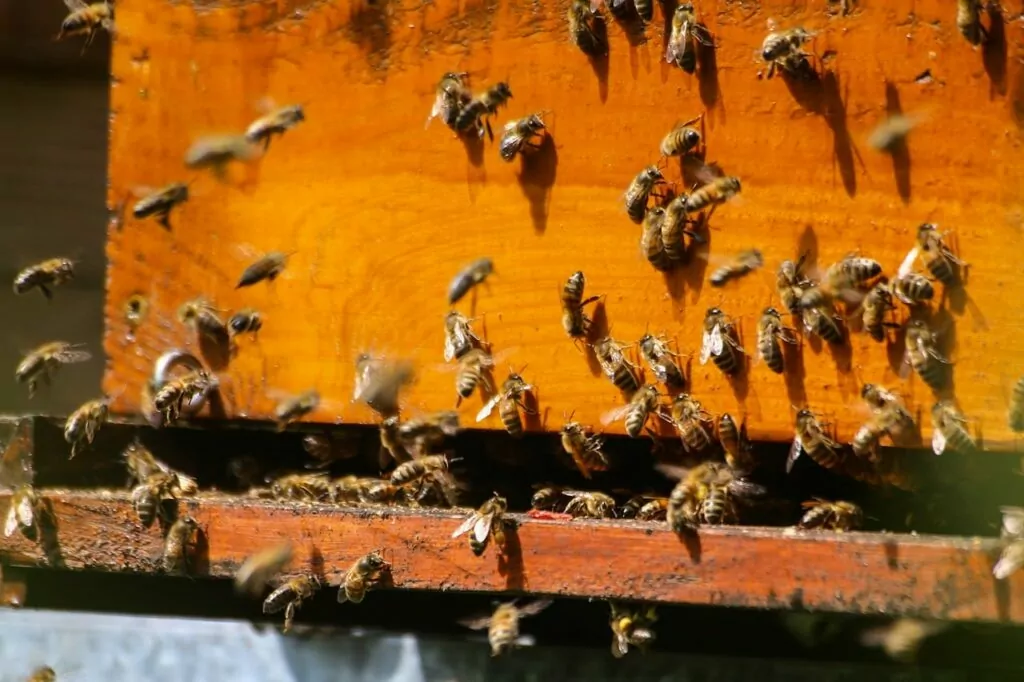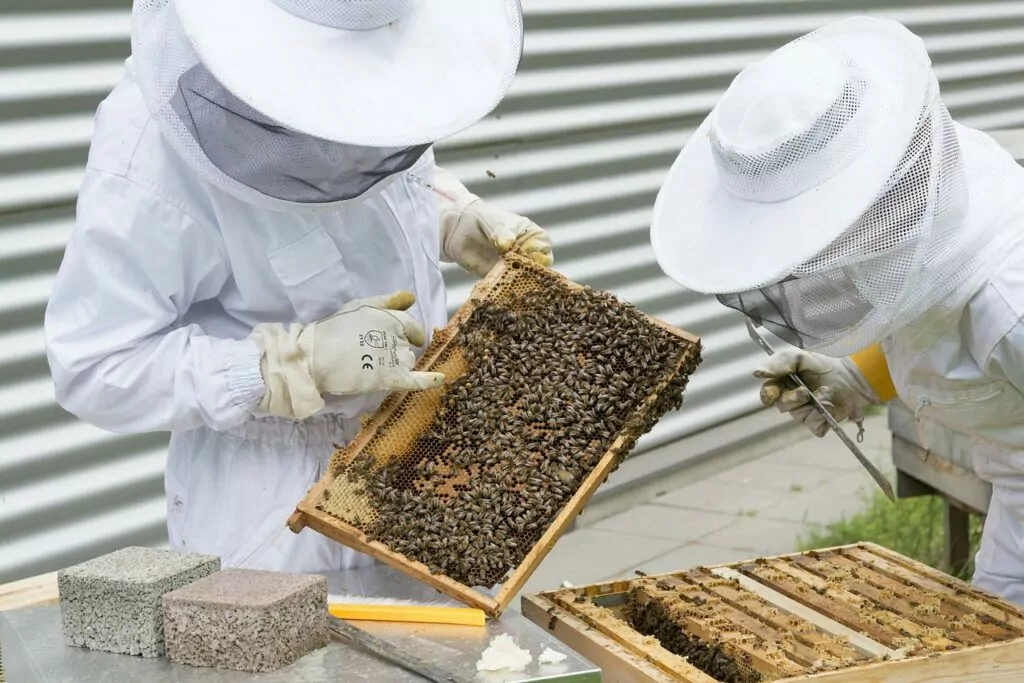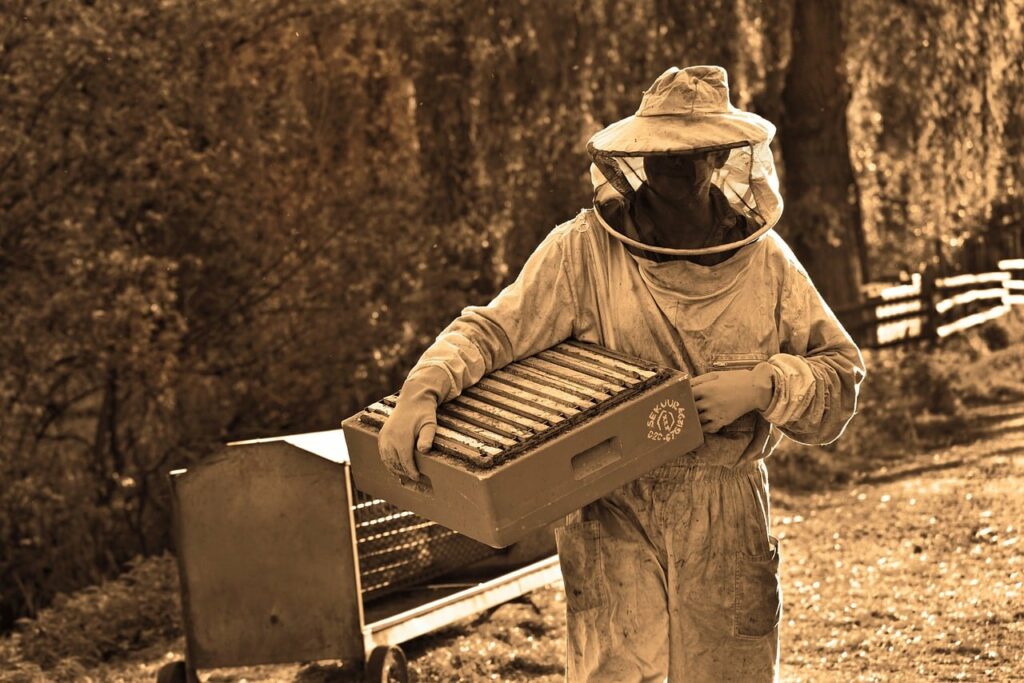You’ve likely crossed paths with one of these buzzing black and yellow insects during your outdoor adventures. What with over 20,000 species worldwide and 4,000 native species in the United States alone.
However, have you ever asked, “Why are bees black and yellow?” Is there a practical purpose for these insects in choosing these palettes?
In this post, we’ll unravel the mystery behind their color choices and explore the science behind these vibrant hues. We’ll also throw some interesting facts about these insects you can share with your bee-loving friends, so keep reading!
The Science Behind Black and Yellow Bee Colors
Honey bees don the vibrant black and yellow stripes for more than just a fashion statement—there’s a fascinating science behind these colors, rooted in adaptation and survival.

Aposematic Coloration
Aposematism is the first theory scientists mention when it comes to animal colorations. It’s a natural alert system among animals, a biological mechanism to signal “danger” to potential predators.
In the world of bees, the striking black and yellow markings aren’t merely a visual treat; it’s a potent warning. It shows predators that bees are not an easy meal—they can sting.
Even from a distance, the conspicuousness of black and yellow stripes makes them ideal danger signals. And scientists believe that this color code is in their very genetic playbook.
In short, their body colors aren’t a mere whim of choice for bees but a result of millions of years of evolution and serving a vital role for their survival.
How Do Warning Colors Work?
The aposematic mechanism is a widely employed strategy in nature, where animals use coloration and sound to discourage potential predators.
Some opt for camouflage, blending into their surroundings, while others boldly showcase bright hues. It’s a common thing among butterflies as well as bees.
Some butterflies mimic toxic species, donning colors and patterns that mirror their dangerous counterparts, fooling predators and showcasing a diversity of nature’s defense strategies.
For bees, the standard view among scientists is that once a predator experiences stinging from a bee, they remember its features and use its colors and other cues to avoid it.
Dr. Nigel Raine, a researcher at Royal Holloway, University of London, highlights this learning process, emphasizing how these warning colors help predators evade future mistakes.
Blending in Nature
Aside from being a warning signal, another commonly held view is that bees use black and yellow stripes for camouflage.
Some experts propose that these contrasting hues function as a form of camouflage known as disruptive coloration. It’s a survival technique that uses high-contrast markings to create optical illusions, distorting an object’s outline.
So, as bees flit from flower to flower, their black and yellow stripes help them seamlessly blend into the vibrant colors of the blossoms, making it challenging for predators to spot them amidst the floral backdrop.
Are All Bees Black and Yellow?

Bees aren’t all black and yellow stripes. Different species of bees naturally display a spectrum of hues and patterns, which researchers attribute to the Hox gene Abd-B, a developmental gene in bees and other insects.
In fact, bee color is never uniform, even among related species, including the ubiquitous honey bees. Genetic diversity within honey bees results in varying shades, making each hive a unique blend.
Carpenter bees wear orange and black, while female carpenter bees flaunt sleek all-black attire. Orchard and sweat bees add a splash of white, orange, green, or even blue.
The environment also plays its part, as distinct color patterns emerge in these insects due to particular environmental pressures.
For instance, tropical bees may exhibit unique spontaneous color preferences than their temperate relatives because of the plants they interact with.
FAQs
Are you still curious about these buzzing insects? Here are some facts and commonly asked questions about bees that might help you.
What is the rarest color of bees?
The rarest color of bees is arguably found in the enchanting Violet Carpenter Bee, scientifically known as Xylocopa violacea. Initially appearing more black than purple, this elusive bee unveils its true beauty in direct sunlight, showcasing brilliant violet wings.
Native to Europe and parts of Asia, including China, these bees face misidentification due to their dark bodies, contributing to the misconception that they are more common than their genuinely rare status suggests.
What is the cutest bee species?
The Teddy Bear Bee, aptly named for its irresistibly cute appearance, claims the title of the world’s cutest bee. Their species is native to Australia and also known among the locals as the golden-haired mortar bee.
Here’s the best part: the males don’t sting, making them adorable and approachable. They’re often mistaken for bumblebees because of their similar colors and features.
What is the friendliest bee on the planet?
The bumblebee stands out as one of the friendliest pollinators. Most people recognized them for their fuzzy appearance and vibrant diversity.
Generally non-aggressive, bumblebees only resort to stinging when threatened or provoked. They live in small colonies, with up to 400 workers, constructing their homes in the ground, under logs, or in vacant burrows.
What does a killer bee look like?
Africanized “killer” bees closely resemble domestic honey bees, although smaller.
Sporting a golden yellow hue with darker brown bands, these bees, more accurately known as African honey bees, are a subspecies of European honey bees kept by beekeepers.
How many bee species are there in North America?
There are approximately 4,000 native bee species that thrive across grasslands, forests, and deserts of North America.
These crucial pollinators, such as Bumble bees, Carpenter bees, Miner bees, Cuckoo bees, Squash bees, Orchard bees, and Blueberry bees, contribute significantly to ecosystem health.
Final Thoughts
To recap, the vibrant black and yellow hues worn by bees are not just a matter of fashion but a result of millions of years of evolution. These colors serve a vital role, acting as both a warning signal to predators and a clever camouflage amid the vibrant blossoms.
The rich diversity in bee colors, influenced by genetic factors and environmental pressures, showcases the intricate tapestry of nature’s adaptive strategies.
So, the next time you marvel at a bee’s black and yellow elegance, remember—it’s not just a color choice but a testament to how remarkable these insects are!
- Why Are Bee Suits White? (The History And Origin Of White Beekeeping Suits) - May 27, 2024
- Why Are Bees Black And Yellow? (Bee Facts and Trivia) - May 21, 2024
- How Do I Get Rid of Ants Without Harming Bees? - April 16, 2024




